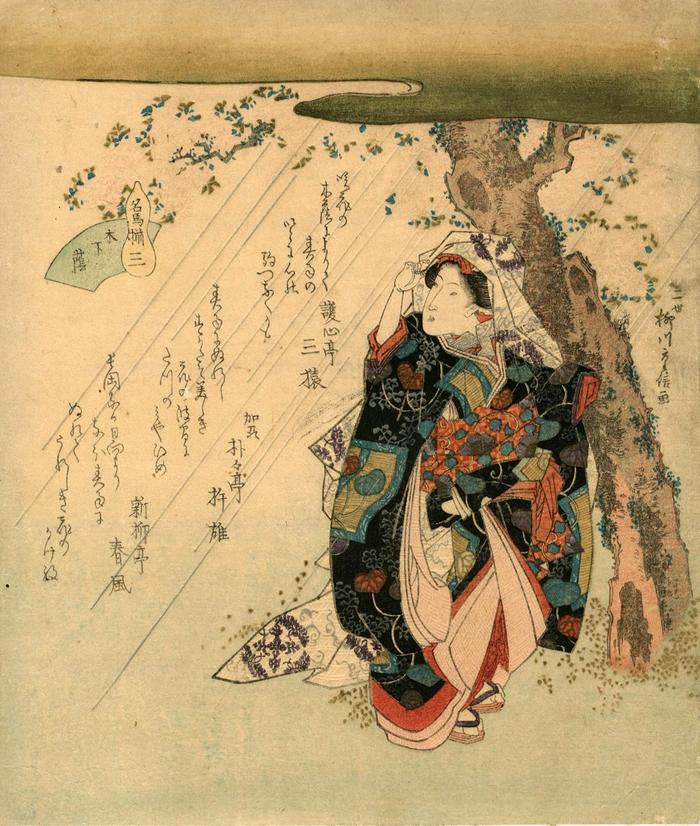Yanagawa Shigenobu II (二代目柳川重信) (artist )
Number Three: In the Shade of a Tree (San konoshitakage - 三 木下蔭) from the series Famous Horses (Meiba zoroe - 名馬揃)
1834
7 in x 8.25 in (Overall dimensions) woodblock print
Signed: Nisei Yanagawa Shigenobu ga
二世柳川重信画 (Second generation Shigenobu)
Museum of Fine Arts, Boston
Art Institute of Chicago
Museum of Fine Arts, Boston - #7, Applying Dye
Museum of Fine Arts, Boston - #5, Silver Coins
Museum of Fine Arts, Boston - #1, Matsukaze
Museum of Fine Arts, Boston - #6, Grinding Ink
Museum of Fine Arts, Boston - #2, Throwing Dice
Museum of Fine Arts, Boston - #4, Usugumo
The Nationaal Museum van Wereldculturen (Rijksmuseum Volkenkunde, Leiden) - via Ritsumeikan University
Chester Beatty Library "This set was produced in 1834, a Horse Year. The series title is written in a cartouche shaped like a gourd. This alludes to the Taoist immortal, Chokkarō, who carried a horse in a gourd and released it whenever he wanted to travel. The title of each picture ends with the syllable ge, or 'fur', a common ending for words that describe the colour of horses. The sharp, precise, detailed engraving of the figures in the set and the intense, saturated colours are typical of the square surimono published in the mid-1830s. There is a pun in the second poem on tatsu, which means both 'dragon' and 'to stand'.
Saku hana no kokage ni yorite harusame no ito ni kokoro no koma tsunagu kamo
'Beneath the flowering cherry tree, I tether the pony of my heart with threads of spring rain'
Goshintei Mizaru
Harusame ni nureshi sugata zo utsukushiki hana no namima ni tatsu no miyahime
'Wet with spring rain, how beautiful she is standing among the waves of flowers, the daughter to the Dragon King'
Bokubokutei Kineo of Kaga ProvinceNodukanaru hinata yori nao harusame ni nurete ureshiki hana no kagemon shinryutei harukaze
'Rather than be sunny and calm, I am happy to be wet with the spring rain, like an embossed pattern of flowers beneath a cherry tree'
Shinryūtei HarukazeFor another impression of this superb design (and others from the series), see Keyes The Art of Surimono pages 319. That copy of this print is from the Chester Beatty Library in Dublin. The above text also comes from that page.
****
Illustrated:
1) in Reading Surimono: The Interplay of Text and Image in Japanese Prints, edited by John T. Carpenter, Hotei Publishing, 2008, p. 359, no. 237.
"A young woman, probably from a wealthy samurai family, stands beneath a blossoming cherry tree and pulls a kazuki shawl over her head to protect herself from the rain. The title of the print, Konoshita-kage 木下陰, literally means 'shade beneath the tree', but also calls to mind the kage 鹿毛, a 'fawn-colored' horse. Konoshita 木下 specifically recalls the steed of that name, which belonged to Minamoto no Nakatsuna who died fighting the Taira clan in the Battle of Ujibashi of 1180 during the Genpei Wars. The story is recounted in the 'Kio' episode of the Tales of Heike.
All three poems somehow allude to or play on part of the phrase Konoshita-kage. In the first poem, kokoro no koma, literally, 'the colt of emotions' is an expression describing the clamorous demands of passion. In the second poem tatsu operates as a pivot word, first as a verb in namima ni tatsu ('stand amidst waves') and then as a proper noun in tatsu no miyahime (Princess of the Dragon), referring to the legendary Dragon King of the seas. In the final poem, kage first forms part of hana no kage (in the shade of blossoms) and then as part of the word kage-mon, literally, 'shadow crest', but referring to a type of clan crest rendered in outline only, the opposite of the hinata-mon, 'sunshine crest', also alluded to in the same poem."
There are some differences in the translations of the three poems - but that always happens when translating Japanese into English. And the names of the poets are variants of the ones shown on this page above.
The first poem is given as:
Drawing near the shade
of a cherry tree in bloom,
will strands of spring drizzle
be strong enough to rein in
the colt of unbridled passion.
Goshintei Sen'en
In the spring drizzle
her moistened vissage
is so alluring - the Princess
of the Dragon King's Palace
stands amid waves of blossoms.
Bokubokutei Kineo, Kashū
Rather than basking
in the gentle light of the sun,
the pale 'shadow' crest
enjoys being moistened
by the spring drizzle.
Shinryūtei Harukaze
2) in 'An electronic transmission analysis of metallic particles in nineteenth century Japanese woodblock prints' by John Fiorillo, Richard Hashimoto and Sarath Menon in Andon 65, April, 2000, figs. 1a and 1b, which is a detail of the gold-colored cloud motif, page 7.
3) in black and white in The Art of Surimono: Privately Published Japanese Woodblock Prints and Books in the Chester Beatty Library, Dublin by Roger Keyes, vol. 2, #271, page 319.
surimono - 摺物 (genre)
